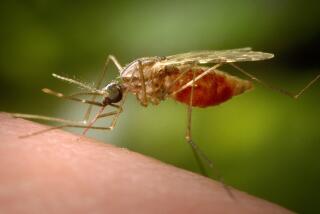Visits home pose risk of illness for some U.S. immigrants
When Los Angeles resident Elias Ferrer flew back to his native Philippines in 2001, he didnât take any precautions against malaria, though the disease is present in rural areas there.
âIt was an emergency trip,â says Ferrer, 54, who was traveling to a funeral.
Though he didnât get sick, if Ferrer were to return now with any of his four children, ages 10 to 21, all of them would follow a preventive regimen such as taking antimalarial pills, he says.
Many U.S. immigrants, however, donât take such precautions when they return to their homelands. They donât realize that the immunity they may have developed to malaria, typhoid fever or other diseases probably has disappeared since they moved to the U.S.
Travel medicine specialists have a term for Ferrer and others like him: VFRs, short for Visiting Friends and Relatives. According to the federal Centers for Disease Control and Prevention, these are largely first- or second-generation immigrants. They constitute about 40% of U.S. international air travelers, according to the U.S. Department of Commerce.
Rates of travel-related infectious diseases are higher among VFRs than among native-born Americans, says Dr. Jay Keystone, a travel medicine expert in Toronto who has written on the subject for the CDC.
Returning immigrants âneed to act like brand-new travelers,â Keystone says. âThe longer they stay in the U.S., the lower their immunity to malaria gets.â
He and other experts say VFRs should not consider themselves immune to diseases that were prevalent during childhood. A report published last year in the Journal of the American Medical Assn. found that VFRs experience higher-than-average levels of exposure to several diseases, including malaria, tuberculosis and dengue fever.
In another report, published Jan. 4 in the Annals of Internal Medicine, Dr. Sonia Angell found these travelers were at high risk for hepatitis A and B, malaria, typhoid fever and tuberculosis.
Angell and Keystone suspect several causes. VFRs may not seek enough health advice before traveling, or they may get information from uninformed sources. VFRs also may spend more time in rural areas, where the risk of disease is higher.
âTheir perception of the risk is different,â Angell says. âIt may be that because they are familiar with these illnesses, they might think they are immune or the risk is not as great.â
Malaria, she says, is a good example. VFRs may have had a low level of protection from contracting the disease before moving to the States, but once they left the area, their bodiesâ natural protection waned.
Immigrants who travel tend to stay abroad longer than other travelers on average, which raises their risk of exposure. Changing immigration patterns also play a role, says Dr. David Boulware, an infectious disease fellow at the University of Minnesota in Minneapolis and coauthor of the Journal of the American Medical Assn. paper. It reported that international migration has risen from 120 million in 1990 to 175 million in 2002.
Where those immigrants come from, of course, plays a key role in how big a threat disease poses when they return to their homeland, Boulware says.
âIf you are going back to Ireland or England,â he says, âitâs pretty much the same as the U.S.â
But VFRs returning home to other countries should seek pre-trip health advice.
âWeâre not just talking about immigrants,â Angell says, âbut also their children.â
*
Healthy Traveler appears every other week. Kathleen Doheny can be reached at [email protected].
More to Read
Sign up for The Wild
Weâll help you find the best places to hike, bike and run, as well as the perfect silent spots for meditation and yoga.
You may occasionally receive promotional content from the Los Angeles Times.






